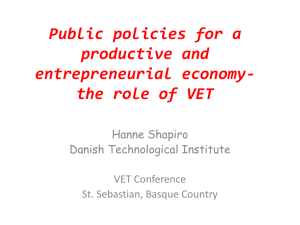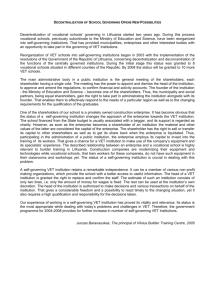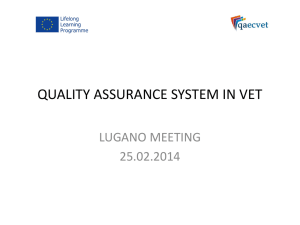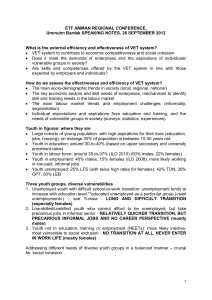Presentation by Dr Saulius Zybartas, Director of the Department of
advertisement
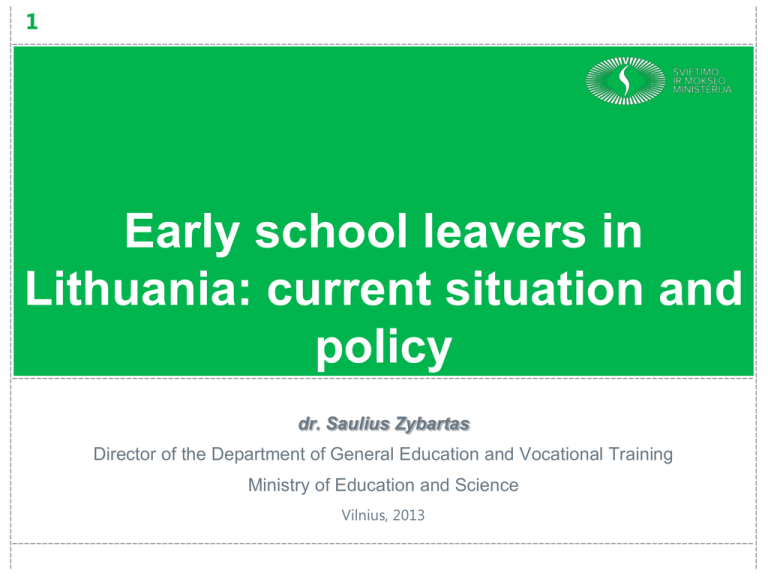
1 Early school leavers in Lithuania: current situation and policy dr. Saulius Zybartas Director of the Department of General Education and Vocational Training Ministry of Education and Science Vilnius, 2013 2 EU recommendations: • • • • Common strategy Evidence-based policy Prevention and early intervention VET prestige 3 Concept definitions Early school leavers aged 18–24 with lower secondary or lower education and not in education 4 weeks prior to the research Dropping out Early school leavers Leaving school because of different reasons. All forms of leaving before acquiring general or equal to general education. Leaving studies without a diploma. Those having started VET programs but not completed with a qualification are considered as VET dropouts School Children of compulsory age for education (7-16 years old), children not in not in programs of primary and lower secondary education education VET dropouts 6,5 8,8 Nyderlandai 7,5 Švedija 4,2 5,3 Slovakija Kroatija 5,5 Šveicarija 4,4 5,5 Čekija Slovėnija 5,7 17,4 17,6 20,1 22,6 2012 Lenkija LIETUVA 7,6 Austrija 8,1 8,9 Suomija Liuksemburgas 9,1 9,7 Danija Airija 10,5 11,4 Kipras Latvija 11,4 Graikija 10,5 11,5 Vengrija Estija 11,6 Prancūzija 10,5 11,7 Makedonija Vokietija 12 Belgija 14,8 13,5 12,5 0 Bulgarija 5 12,8 10 ES 27 Jungtinė Karalystė Norvegija Rumunija Italija Islandija 20,8 20 Portugalija Malta 24,9 25 Ispanija 4 Early school leavers aged 18–24 in Europe Europos 2020 siekinys 15 10 Early school leavers: share of youth aged 18-24, percentage 18 17 16,5 16,1 15,8 16 15,5 15 14,8 14,3 14 14 12 13,5 12,8 13,4 11,4 10 10 10,5 8 8,1 8,2 6 8,7 7,4 7,4 2007 2008 8,1 7,2 6,5 4 2 0 2002 2003 2004 2005 2006 ES 27 2012 City Males Females Lietuva 4,7 2,6 2009 2010 2011 2012 Europos siekinys 2020 Country Males Females 14,3 8,7 2020 6 Early leaving from VET in Lithuania(1) • • Official statistical data evidences that during one school year around 15-16 % of students drop out from VET programmes A wide variation in drop-out rates amongst different VET institutions, varying from several percent to 30% per annum 7 What are the motives for dropping out from VET ? Survey of VET institutions showed that: • • • Major reasons for students to drop out from VET are of a financial (economic) nature: moving abroad or seeking a job in Lithuania Important personal reasons that influence students’ decision to discontinue their education: lack of learning motivation and weak previous preparation at general education institutions. A tendency is observed that sometimes employers with unqualified worker salary “tempt” students to discontinue VET 8 Early school leaving outcomes In 2011 in the EU 54,8 % of early school leavers were unemployed, but around 70 % intended to get a job In Lithuania : one third of early school leavers employed, one third - not employed but with intention to get a job, the rest – not in employment and not intending to get a job • • • In 2012 youth aged 15–24 and unemployed: in the EU - 22,8 % in Lithuania - 26,4 % • • 9 How to prevent early school leaving? Directions to reduce the numbers of early school leavers should include: • • • Preventive mechanisms. Enabling youth to use their learning potential and successfully integrate at school. Intervention mechanisms. Prevention of dropping out: reacting to first signs and offering support to youth at risk. Compensation mechanisms. To help drop outs, offering ways of returning to education and acquiring a qualification. Elements of prevention system 11 Early warning Prepared and implemented information system of dropouts and children not in education– NEMIS. Information collected: dropouts and children/students not in education; reasons, education support offered. • • • In change of education institution information sharing is guaranteed. 12 Measures to reduce drop out from VET • • • • • • Social, educational and psychological support, work with parents Material support, incentives Flexible scheduling for working students and students having children Improvement of learning environment, investments into training basis Student adaptation programmes for “new comers” Career education, meetings with employers and successful graduates to prove that it is worth to have a qualification. 13 th 16 Provisions of the Government of the Republic of Lithuania • • • • • Increasing accessibility of early education and better quality Decisions regarding school network are made on the basis of quality of services provided by school and the importance of the school in the local society Orientation towards high quality secondary education and better accesibility to education for all VET attractiveness to the youth and usefulness for the country and society Better image of VET 14 Implementation of 16th Government programme • • • • • • Action plan for strengthening of lowe-secondary schools and progymnasiums Yellow buses programme for 2013–2017 Action plan for increasing access to inclusive education Prevention programmes for safe school non-formal education Children and youth socialisation action plan Vocational education and training development action plan 15 Planned investments in ESF 2014-2020 period Investment priority (9.2) “Prevention and reducing of drop-outs number and securing of equal conditions to gain high-quality prie-primar, primary, basic and upper-secondary education“ Concrete objective: “To decrease number of early drop outs and number of students who haven;t finished general education programme” (9.2.2) 16 Thank you for your attention


